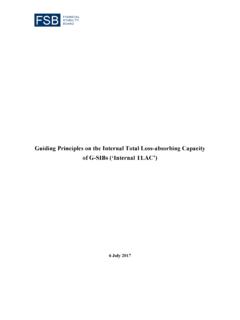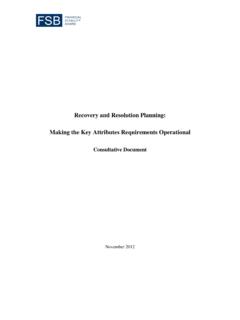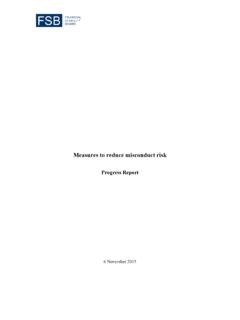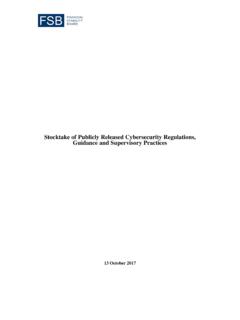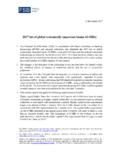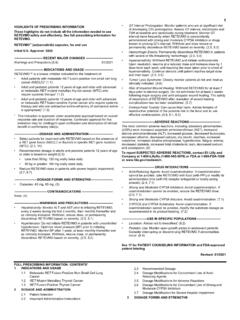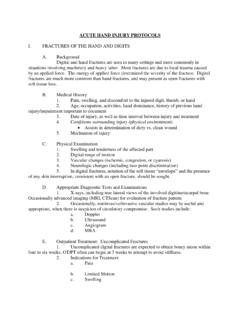Transcription of Key Attributes of Effective Resolution Regimes for ...
1 1 An update was published in October 2014. Key Attributes of Effective Resolution Regimes for financial Institutions October 2011 2 Table of Contents Foreword .. 1 Preamble .. 3 1. Scope .. 5 2. Resolution authority .. 5 3. Resolution powers .. 7 4. Set-off, netting, collateralisation, segregation of client assets .. 10 5. Safeguards .. 11 6. Funding of firms in Resolution .. 12 7. Legal framework conditions for cross-border cooperation .. 13 8. Crisis Management Groups (CMGs) .. 14 9. Institution-specific cross-border cooperation agreements .. 14 10. Resolvability assessments .. 15 11. Recovery and Resolution planning .. 16 12. Access to information and information sharing.
2 18 Annex I. Essential elements of institution-specific cross-border cooperation 21 II. Resolvability 27 III. Essential elements of recovery and Resolution 33 IV. Temporary stay on early termination 41 1 Foreword The Key Attributes of Effective Resolution Regimes for financial Institutions (the Key Attributes ) set out the core elements that the FSB considers to be necessary for an Effective Resolution regime . Their implementation should allow authorities to resolve financial institutions in an orderly manner without taxpayer exposure to loss from solvency support, while maintaining continuity of their vital economic functions. They set out twelve essential features that should be part of the Resolution Regimes of all jurisdictions.
3 They relate to: 1. Scope 2. Resolution authority 3. Resolution powers 4. Set-off, netting, collateralisation, segregation of client assets 5. Safeguards 6. Funding of firms in Resolution 7. Legal framework conditions for cross-border cooperation 8. Crisis Management Groups (CMGs) 9. Institution-specific cross-border cooperation agreements 10. Resolvability assessments 11. Recovery and Resolution planning 12. Access to information and information sharing. Not all Resolution powers set out in the Key Attributes are suitable for all sectors and all circumstances. To promote Effective and consistent implementation across jurisdictions the FSB will continue to work with its members to develop further guidance, taking into account the need for implementation to accommodate different national legal systems and market environments and sector-specific considerations ( , insurance, financial market infrastructures).
4 The Annexes I to IV provide more specific guidance to assist authorities in implementing the Key Attributes with respect to: institution-specific cross-border cooperation agreements (Annex I) resolvability assessments (Annex II) Recovery and Resolution Plans (Annex III) temporary stays on early termination rights (Annex IV). 2 3 Preamble The objective of an Effective Resolution regime is to make feasible the Resolution of financial institutions without severe systemic disruption and without exposing taxpayers to loss, while protecting vital economic functions through mechanisms which make it possible for shareholders and unsecured and uninsured creditors to absorb losses in a manner that respects the hierarchy of claims in liquidation.
5 An Effective Resolution regime (interacting with applicable schemes and arrangements for the protection of depositors, insurance policy holders and retail investors) should: (i) ensure continuity of systemically important financial services, and payment, clearing and settlement functions; (ii) protect, where applicable and in coordination with the relevant insurance schemes and arrangements such depositors, insurance policy holders and investors as are covered by such schemes and arrangements, and ensure the rapid return of segregated client assets; (iii) allocate losses to firm owners (shareholders) and unsecured and uninsured creditors in a manner that respects the hierarchy of claims; (iv) not rely on public solvency support and not create an expectation that such support will be available; (v) avoid unnecessary destruction of value, and therefore seek to minimise the overall costs of Resolution in home and host jurisdictions and, where consistent with the other objectives, losses for creditors; (vi) provide for speed and transparency and as much predictability as possible through legal and procedural clarity and advanced planning for orderly Resolution .
6 (vii) provide a mandate in law for cooperation, information exchange and coordination domestically and with relevant foreign Resolution authorities before and during a Resolution ; (viii) ensure that non-viable firms can exit the market in an orderly way; and (ix) be credible, and thereby enhance market discipline and provide incentives for market-based solutions. Jurisdictions should have in place a Resolution regime that provides the Resolution authority with a broad range of powers and options to resolve a firm that is no longer viable and has no reasonable prospect of becoming so. The Resolution regime should include: (i) stabilisation options that achieve continuity of systemically important functions by way of a sale or transfer of the shares in the firm or of all or parts of the firm s business to a third party, either directly or through a bridge institution, and/or an officially mandated creditor-financed recapitalisation of the entity that continues providing the critical functions; and 4 (ii) liquidation options that provide for the orderly closure and wind-down of all or parts of the firm s business in a manner that protects insured depositors, insurance policy holders and other retail customers.
7 In order to facilitate the coordinated Resolution of firms active in multiple countries, jurisdictions should seek convergence of their Resolution Regimes through the legislative changes needed to incorporate the tools and powers set out in these Key Attributes into their national Regimes . 5 1. Scope Any financial institution that could be systemically significant or critical if it fails should be subject to a Resolution regime that has the Attributes set out in this document ( Key Attributes ). The regime should be clear and transparent as to the financial institutions (hereinafter firms ) within its scope. It should extend to: (i) holding companies of a firm; (ii) non-regulated operational entities within a financial group or conglomerate that are significant to the business of the group or conglomerate; and (iii) branches of foreign financial market infrastructures ( FMIs )2 should be subject to Resolution Regimes that apply the objectives and provisions of the Key Attributes in a manner as appropriate to FMIs and their critical role in financial markets.
8 The choice of Resolution powers should be guided by the need to maintain continuity of critical FMI The Resolution regime should require that at least all domestically incorporated global SIFIs ( G-SIFIs ): (i) have in place a recovery and Resolution plan ( RRP ), including a group Resolution plan, containing all elements set out in Annex III (see Key attribute 11); (ii) are subject to regular resolvability assessments (see Key attribute 10) ; and (iii) are the subject of institution-specific cross-border cooperation agreements (see Key attribute 9). 2. Resolution authority Each jurisdiction should have a designated administrative authority or authorities 1 This should not apply where jurisdictions are subject to a binding obligation to respect Resolution of financial institutions under the authority of the home jurisdiction (for example, the EU Winding up and Reorganisation Directives).
9 2 For the purposes of this document, the term financial market infrastructure is defined as a multilateral system among participating financial institutions, including the operator of the system, used for the purposes of recording, clearing, or settling payments, securities, derivatives, or other financial transactions . It includes payment systems, central securities depositories (CSDs), securities settlement systems (SSSs), central counterparties (CCPs), and trade repositories (TRs). See CPSS-IOSCO - Consultative report on Principles for financial market infrastructures - March 2011. 3 CPSS and IOSCO are undertaking joint work on recovery and Resolution issues for FMIs. On recovery, this includes reviewing ex ante loss-sharing rules.
10 On Resolution , this includes a review of whether specific Resolution arrangements for FMIs are needed. If, based on their findings, the FSB concludes that special Resolution arrangements for FMIs are required, it will, with the involvement of CPSS and IOSCO, review which Key Attributes specifically apply to FMIs and whether further specific powers need to be incorporated in the Key Attributes to address their Resolution . 6 responsible for exercising the Resolution powers over firms within the scope of the Resolution regime ( Resolution authority ). Where there are multiple Resolution authorities within a jurisdiction their respective mandates, roles and responsibilities should be clearly defined and coordinated.
